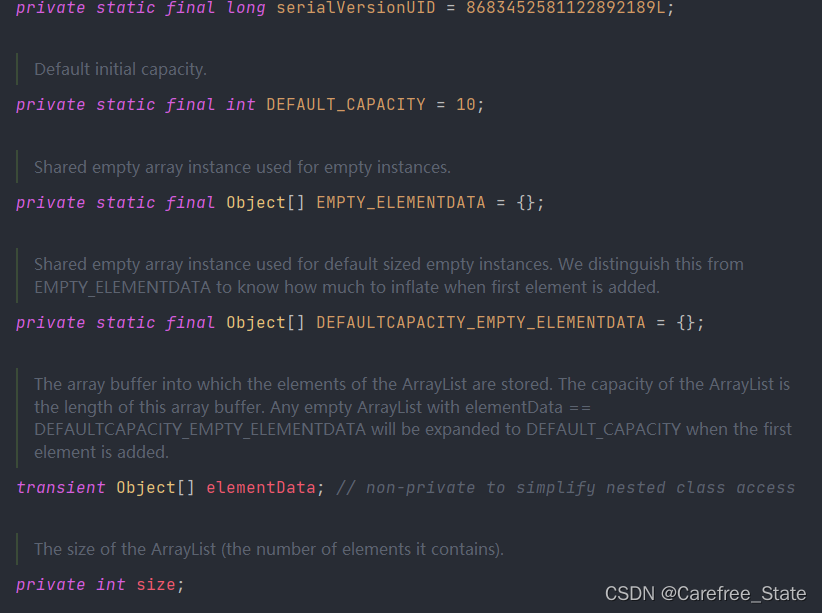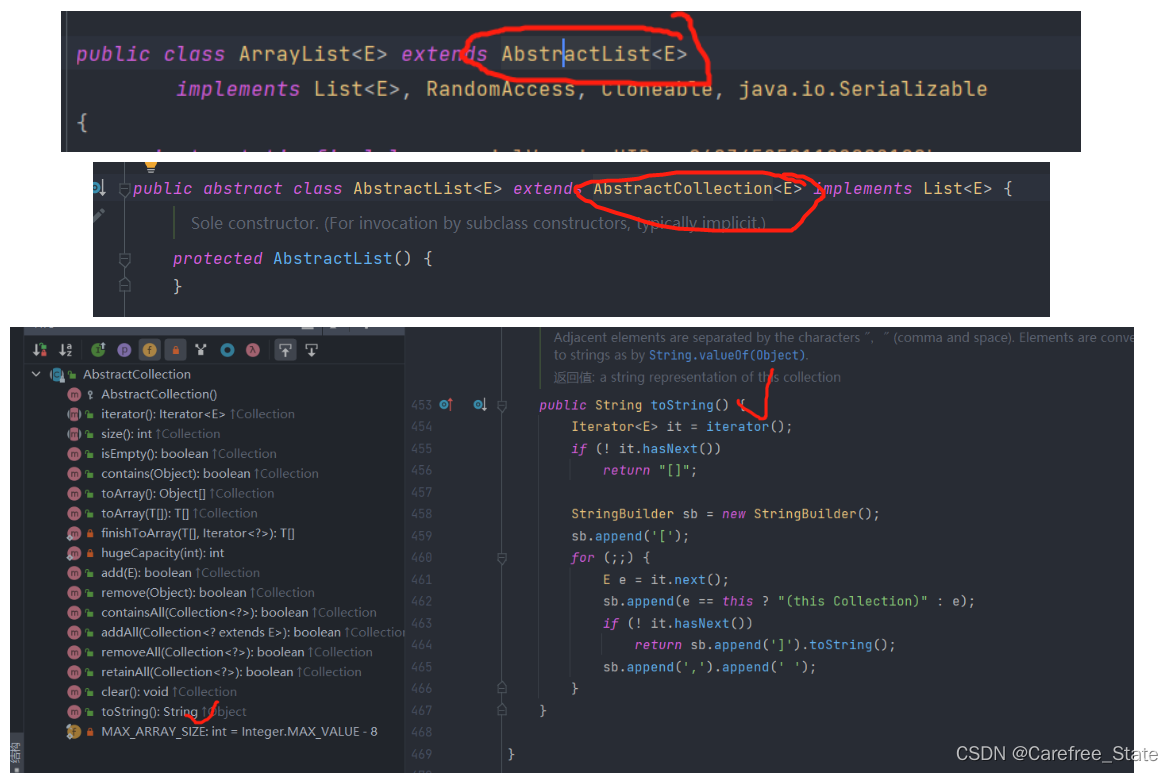Java数据结构 & ArrayList顺序表
- 我们平时很喜欢使用的数组,就是顺序表!
- 下面我们将以 “模拟ArrayList” 的视角来盘一盘顺序表吧!

1. ArrayList的模拟
- 首先,这个类的功能如下:
- 能够完成增删改查基础操作
- 能够自动扩容(隐性,让这个顺序表能够存储足够多的数据)
- 在一个类中放数据,这样可以给类加上一些方法,那么这个类的功能就更加丰富且有针对性,就像包装起来的一组东西(包括数组整体)
- 在后面的链表集合类LinkedList中,虽然链表可用链表头结点表示(代表),但是这个类就是节点类吗,节点只是存储的方式,而集合类是包装起来的一组东西,即对象,通过这个对象,使用丰富的属性(包括这个链表整体)和方法

1.1 ArrayList的基础模板
- 总的模板如下(具体个别方法在后面)
public class MyArrayList {
public int[] elem;
public int usedSize;//0
//默认容量
private static final int DEFAULT_SIZE = 10;
public MyArrayList() {
this.elem = new int[DEFAULT_SIZE];
}
public MyArrayList(int size) {
if (size <= 0) {
throw new IndexException("MyArraylist");
}
this.elem = new int[size];
}
/**
* 打印顺序表:
* 根据usedSize判断即可
*/
public void display() {
}
// 新增元素,默认在数组最后新增
public void add(int data) {
}
public boolean isFull() {
}
/**
* 判断当前的顺序表是不是满的!
*
* @return true:满 false代表空
*/
private boolean checkPosInAdd(int pos) {
}
// 在 pos 位置新增元素
public void add(int pos, int data) {
}
// 判定是否包含某个元素
public boolean contains(int toFind) {
}
// 查找某个元素对应的位置
public int indexOf(int toFind) {
}
// 获取 pos 位置的元素
public int get(int pos) {
}
private boolean isEmpty() {
}
// 给 pos 位置的元素设为【更新为】 value
public void set(int pos, int value) {
}
/**
* 删除第一次出现的关键字key
*
* @param key
*/
public void remove(int key) {
}
// 获取顺序表长度
public int size() {
}
// 清空顺序表
public void clear() {
}
}
1.1 属性
public int[] elem;
public int usedSize;//0
//默认容量
private static final int DEFAULT_SIZE = 10;
elem顺序表“本体”usedSize顺序表已添加的有效数据DEFAULT_SIZE(不带参数的构造方法,在构造数组时的默认容量)
1.2 方法
1.2.1 构造方法
- 非正常操作的异常
public class IndexException extends RuntimeException{
public IndexException() {
}
public IndexException(String message) {
super(message);
}
}
public MyArrayList() {
this.elem = new int[DEFAULT_SIZE];
}
public MyArrayList(int size) {
if (size <= 0) {
throw new IndexException("MyArraylist");
}
this.elem = new int[size];
}
- 不带参数的构造方法
- 以默认值构造数组
- 带参数的构造方法
- 以传入的值作为起始容量
1.2.2 遍历方法
- 这个没啥好说的
/**
* 打印顺序表:
* 根据usedSize判断即可
*/
public void display() {
if(isEmpty()) {
System.out.println("[]");
}
else{
System.out.print("[ ");
for (int i = 0; i < this.usedSize; i++) {
if(i == usedSize - 1) {
System.out.print(this.elem[i] + " ]");
}else {
System.out.print(this.elem[i] + ", ");
}
}
System.out.println();
}
}
1.2.3 增加元素方法以及判断是否满方法

-
我们只需要在
elem[usedSize] = data即可-
然后
usedSize++,这样就刚好添加到数组的末尾 -
但是,如果数组满了的话怎么办?
-
那就要扩容一下了
-

-
copyOf()这个方法可以动态调整数组的大小,对比于C语言,这个方法更加全能 -
elem 2 * usedSize 被拷贝的数组 新数组的大小(我这里扩大两倍)
-
-
-
// 新增元素,默认在数组最后新增
public void add(int data) {
if (isFull()) {
//满了即扩容
elem = Arrays.copyOf(elem, 2 * usedSize);
}
elem[usedSize] = data;
usedSize++;
}
//is...() 这种命名一般返回boolean类型,起判断作用
public boolean isFull() {
if (usedSize == elem.length) {
return true;
} else {
return false;
}
}
- 我们还可以在指定位置进行插入(需要检验下标是否合理)
- 我们需要将对应位置以及后面的元素都向后挪动,腾出一个位置给待插入的元素(检验是否需要扩容)
- 从尾挪动

//检验下标是否合理的方法
private boolean checkPosInAdd(int pos) {
if (pos < 0 || pos > this.usedSize) {
return false;
}
return true;//合法
}
// 在 pos 位置新增元素,构成重载
//pos刚好在末尾,是允许的
public void add(int pos, int data) {
if (this.isFull()) {
elem = Arrays.copyOf(elem, 2 * usedSize);
}
if (checkPosInAdd(pos)) {
usedSize++;
for (int i = usedSize; i > pos; i--) {
elem[i] = elem[i - 1];
}
elem[pos] = data;
}else {
throw new IndexException("add");
}
}
1.2.4 查找方法
- 第一个查找-> 找得到返回true 否则false
- 第二个查找-> 找得到返回对象下标,找不到返回-1(-1下标在java中完全用不了)
- C语言中,访问下标arr[-1] = (arr - 1);
// 判定是否包含某个元素
public boolean contains(int toFind) {
for (int i = 0; i < this.usedSize; i++) {
if (elem[i] == toFind) {
return true;
}
}
return false;
}
// 查找某个元素对应的位置
public int indexOf(int toFind) {
for (int i = 0; i < this.usedSize; i++) {
if (elem[i] == toFind) {
return i;
}
}
return -1;
}
1.2.5 获取下标元素方法
// 获取 pos 位置的元素
public int get(int pos) {
if (checkPosInAdd(pos)) {
if (pos == usedSize) {
//下标不合理就会抛异常
throw new IndexException("get");
} else {
//返回对应元素的值
return elem[pos];
}
} else {
//下标不合理就会抛异常
throw new IndexException("get");
}
}
1.2.6 更新下标对应元素方法
// 给 pos 位置的元素设为【更新为】 value
// 即使pos刚好对应末尾,只要是“空的”就不能够设置
public void set(int pos, int value) {
if (checkPosInAdd(pos)) {
if (pos == usedSize) {
throw new IndexException("set");
} else {
this.elem[pos] = value;
}
} else {
throw new IndexException("set");
}
}
1.2.7 是否空以及获取顺序表元素个数方法
private boolean isEmpty() {
return usedSize == 0;
}
// 获取顺序表长度
public int size() {
return usedSize;
}
1.2.8 删除元素方法
- 对于第一次出现的key值,进行删除
- 后面的所有元素要把这个空位补上去(也就是一个个挪动过去)
- 从头挪动

- 后面的所有元素要把这个空位补上去(也就是一个个挪动过去)
/**
* 删除第一次出现的关键字key
*
* @param key
*/
public void remove(int key) {
int index = indexOf(key);
if (index == -1) {
System.out.println("Can‘t find");
} else {
for (int i = index; i < usedSize - 1; i++) {
this.elem[i] = this.elem[i + 1];
}
usedSize--;
}
}
-
清空顺序表的方法:
-
// 清空顺序表 public void clear() { this.elem = new int[DEFAULT_SIZE]; this.usedSize = 0; }
-
1.3 测试
public class Test {
public static void main(String[] args) {
MyArrayList myArrayList = new MyArrayList(5);
myArrayList.display();
myArrayList.add(1);
myArrayList.add(2);
myArrayList.add(3);
myArrayList.display();
System.out.println(myArrayList.indexOf(3));
System.out.println(myArrayList.contains(3));
System.out.println(myArrayList.indexOf(4));
System.out.println(myArrayList.contains(4));
myArrayList.add(4);
myArrayList.add(5);
myArrayList.add(6);
myArrayList.display();
myArrayList.add(2, 99);
System.out.println(myArrayList.get(2));
myArrayList.display();
myArrayList.set(3, 99);
myArrayList.display();
myArrayList.remove(4);
myArrayList.display();
System.out.println(myArrayList.size());
myArrayList.clear();
myArrayList.display();
}
}

- 测试结果正常!
2. ArrayList的使用以及系统源码的一些细节
-

-
E 是一个泛型类(不能用基本数据类型)
-
List<Integer> list = new ArrayList<>();- 这个是最常用的使用方式, 一般实例化List接口,这样功能更加具体
-
如果是自定义类的话,一定要重写
equals()方法,因为在查找的时候,判断是否相同尤为重要- 重写
compareTo()方法更好,在用工具类Collections去排序的时候要用到
- 重写
2.1 属性

- 重点:
- 默认数组大小,
DEFAULT_CAPACITY - 本体数组,
elementData[] - 有效元素个数,
size
2.2.1 构造方法

-
带参数int的构造方法
-
提供自定义数组大小,非法下标则抛异常
-

-
等于0的情况,则给一个空数组

-
-
不带参数的构造方法
- 以默认的数组大小构造数组

-
提供一整个集合类对象作为参数的构造方法
-
即直接将这个集合类对象的所有元素,拷贝一份下来整合成顺序表返回
-

-
但是这个集合类对象的泛型类型必须是E的子类或者E本身
-
2.2.2 常用方法
- 高亮即重点
| 方法 | 解释 |
|---|---|
| boolean add(E e) | 尾插e,(返回true) |
| void add(int index, E element) | 指定位置插入元素 |
| boolean addAll(Collection c) | 尾插一集合的所有元素 |
| E remove(int index) | 删除指定下标的元素 |
| boolean remove(Object o) | 删除第一个指定元素(不存在返回false) |
| E get(int index) | 获取下标对应元素 |
| E set(int index, E element) | 设置下标对应元素(必须存在) |
| void clear() | 清空顺序表 |
| boolean contains(Object o) | 判断此元素是否存在于顺序表 |
| int indexOf(Object o) | 返回第一个对应元素下标 |
| int lastIndexOf(Object o) | 从后往前找第一个对应元素的下标 |
| List subList(int fromIndex, int toIndex) | 截取对应顺序表(sub形式的方法一般返回的对象与原对象是共用的) |
- 使用这些方法的方式更上一部分相似
2.3 顺序表的遍历
2.3.1 for-each循环(不是foreach方法)
for(Integer i : list) {
System.out.print(i + " ");
}
2.3.2 for循环
for(int i = 0; i < list.size(); i++) {
System.out.print(list.get(i) + " ");
}
2.3.3 listIterator() =》Iterator 迭代器实现
- 了解即可
Iterator<Integer> iterator = list.listIterator();
while(iterator.hasNext()) {
System.out.print(iterator.next() + " ");
}
2.3.4 直接sout(快捷)打印
- 前提是知道泛型类型的打印方法!!!
- 所以我们的自定义类型就必须重写
toString()方法
- 所以我们的自定义类型就必须重写
System.out.print(list);
- 不难发现,List,ArrayList两个类都没有重写toString方法
- 那么这个类的对象是怎么打印的那?
- 其实可以在这之前已经重写好了

2.4 toArray() 方法

-
不带参数的构造方法,直接返回对应的数组,数据类型为Object[] 需要强制类型转化为对应的类型,(由于此时的Object是对应的类型实例化的,所以不会有问题)
System.out.println(list.toArray()[0] instanceof Integer);
-
带参数,即直接对提供的数组进行修改,返回值跟上面一样
- 注意:不能用基本数据类型的数组,且基本数据类型数组与对象数组之间不能进行拆箱装箱
2.5 ArrayList扩容机制

- 简单的来说就是
- 满了扩容
- 用
copyOf()1.5倍扩容(位操作符速度快) - 超过最大容量报错
3. 实例
- 到这里,ArrayList的基本使用与原理知识已经讲解完了,
- 下面是一个小项目,可以去提高自己对顺序表的理解
- 大家可以通过我写的博客去理解和完成
3.1 扑克牌系统-斗牛
(21条消息) JavaProject & 洗牌斗牛系统_Carefree_State的博客-CSDN博客
3.2 拓展:八皇后问题(非必要方法,只是结合ArrayList去解决罢了)
(21条消息) 《八皇后问题》& Java数据结构 & JavaProject & JavaOJ题集_Carefree_State的博客-CSDN博客
3.3 杨辉三角
- 二维顺序表的表示(解题类似二维数组)

class Solution {
public static List<List<Integer>> generate(int numRows) {
List<List<Integer>> list = new ArrayList();
for(int i = 0; i < numRows; i++) {
list.add((List<Integer>)new ArrayList());
for(int j = 0; j < i + 1; j++) {
if(j == 0 || i == j) {
list.get(i).add(1);
}else if(i > 1 && j > 0 && j < i) {
list.get(i).add(list.get(i - 1).get(j - 1) + list.get(i - 1).get(j));
}
}
}
return list;
}
}
public class Test {
public static void main(String[] args) {
Scanner scanner = new Scanner(System.in);
int scan = scanner.nextInt();
List list = Solution.generate(scan);
System.out.println(list);
}
}
文章到此结束!谢谢观看
可以叫我 小马,我可能写的不好或者有错误,但是一起加油鸭🦆!这是我的代码仓库!(在马拉圈的23.1 / 23.2里)代码仓库
























 503
503











 被折叠的 条评论
为什么被折叠?
被折叠的 条评论
为什么被折叠?










